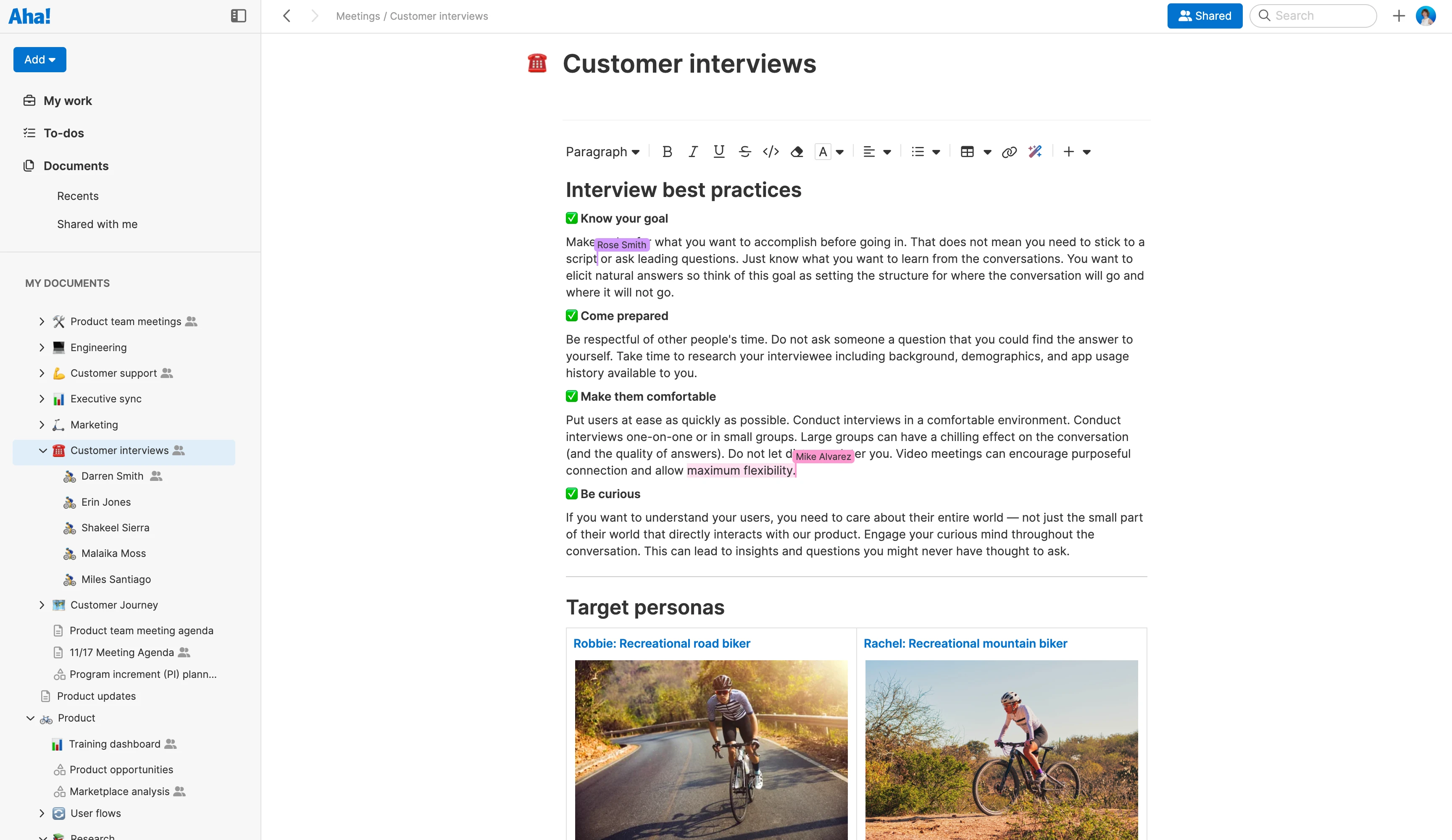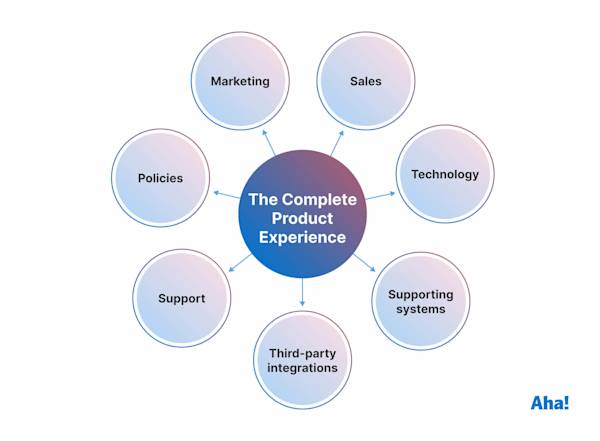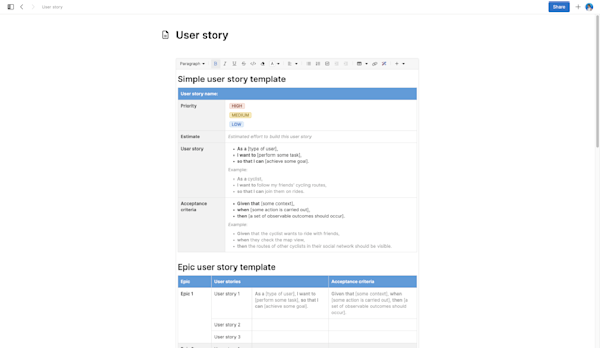Consolidating product documentation sounds simple enough. But our team of experts at Aha! speaks with hundreds of product builders every week — we know the reality is far more complex. Product teams have notes scattered across tools and formats. Documentation is often outdated, incomplete, or difficult to understand. And sometimes, you cannot find what you need when you need it.
We want to help untangle the mess. In this guide, we will explore the benefits of a strong product team knowledge base, who should own it, and practical tips for building (and improving) your own team's docs.
Feel free to jump ahead to any section:
Top
The value of a central product knowledge base
If you find that consolidating product documentation in one place continually falls to the bottom of your priority list, you are not alone. Most product managers are so busy focusing on daily tasks and responsibilities that crafting, compiling, and updating documentation can feel like it is not urgent enough to tackle.
But the benefits of centralized product docs are worth the effort:
Alignment: Documenting and sharing knowledge brings the team together. Everyone understands how they contribute to the product goals and feels motivated to maintain consistency across their work.
Clarity: Clarity ensures the entire team can easily find out who is responsible for what, how the team works together, and why (and how) product decisions are made.
Efficiency: The right resources and knowledge — organized in a standardized way within a single tool — help team members and new hires find what they need and accomplish tasks faster.
Value: Centralized product documents ensure team members can easily keep information up to date, share ideas, and incorporate feedback. They can then iterate to build a better product and deliver greater value.
In short, a product knowledge base helps the entire team get aligned and achieve more, faster, with the right information always accessible. And when a stakeholder or teammate asks where they can find something, you will know exactly where to direct them. Codifying team processes and workflows also necessitates thinking deeply about the work you do. By outlining your mindset around the product development process and how you strive to build better products, you can focus on making the most impact.
Top
What are the different types of internal product documents?
Internal product documents can be quite complex and multifaceted. As we mentioned before, internal product docs usually fall into six broad categories: foundational, industry best practices, market research, team processes, knowledge capture, and training. But the ways you use and update individual docs may vary.
For instance, you might create a foundational pricing plan chart just once and then revisit it yearly to make adjustments. On the other hand, a best practices doc for stakeholder alignment might need more frequent updates as you hone what works best or as new people join the organization.
Your approach to documentation also depends on what stage of the product development lifecycle you are in. For example, compiling initial market and competitor research for a startup will be different than drafting an established team's go-to-market process for launching new functionality.
The following table includes some of the key documents we recommend creating and organizing within your team's product knowledge base:
Category | Types of documents |
Foundational product information | |
Industry best practices | Agile methodologies, frameworks, and development processes UX design principles Web accessibility Industrywide IT and security guidelines Compliance, regulatory, and legal guidelines Links to relevant thought leadership content
|
Market research
| |
Team processes | |
Knowledge capture | |
Training | |
Compiling the above in a single place is a great start. But our team sees even greater value in storing these documents in the same system we use to manage daily product work. Internally, we use Aha! Knowledge as our product knowledge base — it includes notes, collaborative whiteboards, and guided templates. And it integrates seamlessly with Aha! Roadmaps, where we build structured roadmap plans. This way, all of our information is contextualized, easy to find, and links over to our detailed product development work.
Related:
Top
Who is responsible for internal product documentation?
As a product manager or product operations manager, you are often in charge of drafting and maintaining product documents. Despite this, you do not necessarily make the actual decisions that go into the documentation — company and product leaders do. We know this can feel cloudy, especially if you are part of an organization that does not yet have strong documentation practices in place.
But there are ways you can start small and do your part:
Bring up the need for better documentation with your manager and offer to audit what the team has and what it needs.
Begin by creating or updating one or two straightforward documents, such as role descriptions for the product team or best practices for a sprint retrospective. Prioritize from there.
Leverage a process improvement template to communicate a cross-functional team process that needs refinement.
As teammates find value in these documents, you will gain support. Most people want the clarity and predictability that comes with codifying team practices. They will be relieved that documentation is easier to access and follow.
Related:
Top
What are the differences between internal and external product documentation?
Internal product docs capture your why, what, and how — in other words, all the steps needed to map out and build your product. External product docs are customer-facing resources describing how to use your product. These external documents often reside in a knowledge base or self-serve help center. Common examples of external product docs include support articles, release notes, product announcements, and how-to videos.
Here is a summary of the differences between the two:
| Internal product documents | External product documents |
Purpose and audience | Internal teams (primarily product and engineering) refer to these docs to gain the knowledge they need to do their product development work. Ideally, the entire organization should be able to view these resources. | Customers refer to external product docs when they want to get started with your product quickly or have questions they need to resolve. |
Ownership | Company leaders typically set the charter. Product managers or product operations managers then create and maintain these docs. (Other teams might own select product documents — think engineering being responsible for deployment or debugging instructions.) | Following the product team's decisions and new functionality that it releases, members of the customer support team usually work together with knowledge base managers and technical writers to draft external product docs. |
Cadence | Although some internal product docs only require periodic updates, others need daily or weekly updates to stay accurate and comprehensive. Be sure to adjust the information in your docs as your product evolves. | The frequency of updates to external product documents depends on the organization, the type of product it offers, and its release cadence. For software companies that release new functionality frequently, external docs might be published on a weekly or biweekly cadence. |
Top
Tips for creating strong internal product documentation
Excellent internal product documents are clear, comprehensive, up to date, and accessible. It can be helpful to follow an editorial style guide and use a peer review process to ensure consistency and accuracy. This also helps to establish a regular schedule for maintaining or refreshing documents.
Here are some additional tips on how to create strong internal documentation:
1. Establish a document hierarchy
Start by determining the purpose and audience for the types of documents in your knowledge base. Who will make the decisions, who will write the actual documentation, and who will provide feedback? You might want to organize your information by:
Company: information that everyone in the organization needs to access
Divisions and subdivisions: resources for specific business units
Products and product teams: product-related documents for each product or team
Individual: private notes that capture initial ideas and thoughts
2. Choose a knowledge base tool
Of course, using the right tools is essential for creating or improving your documentation. Naturally, we are biased because we think Aha! Knowledge is the best way to capture and streamline this information. Whatever tool you choose, you want to make sure it supports the way you work. For us, that means offering the ability to add media, use built-in AI functionality, and leverage rich formatting and purpose-built templates for notes, visual whiteboards, flowcharts, matrices, plans, and more.
3. Create a style guide
Consistency is key for shared documentation. Establish a few company or brand rules around how folks should capture, present, and share the written and visual information in your knowledge base. Besides paying attention to the format and tone of the content you are creating, you will also want to define spelling and grammar conventions.
4. Organize the information
Create folders and subfolders to capture different types of information in your knowledge base. You can then arrange them in a logical order. For example, you might create a parent folder to contain all of the product team's meeting notes and make subfolders to group them by month or quarter.
5. Consolidate documents
Most teams have product-related information scattered across several tools. Import documentation from other places to bring all of your documents into location. For instance, if you use Aha! software you can import notes from Confluence.
6. Share with stakeholders
Product team members, leadership, cross-functional teammates, and external stakeholders need different levels of access to product documents. Define which people should be decision makers, contributors, or reviewers. Their access levels will depend on what they need to know and how much input they should offer.
7. Start documenting
Capture the information your team needs to achieve its best work. Use notes in your knowledge base for text-based information (such as customer research and meeting agendas). Use whiteboards for more visual activities (such as brainstorming product ideas or mapping out the customer journey).
Having the right information in the right places can transform your product development efforts. When everyone is aligned around a common purpose and the resources necessary to achieve that purpose, you can all focus on building more lovable products together.



